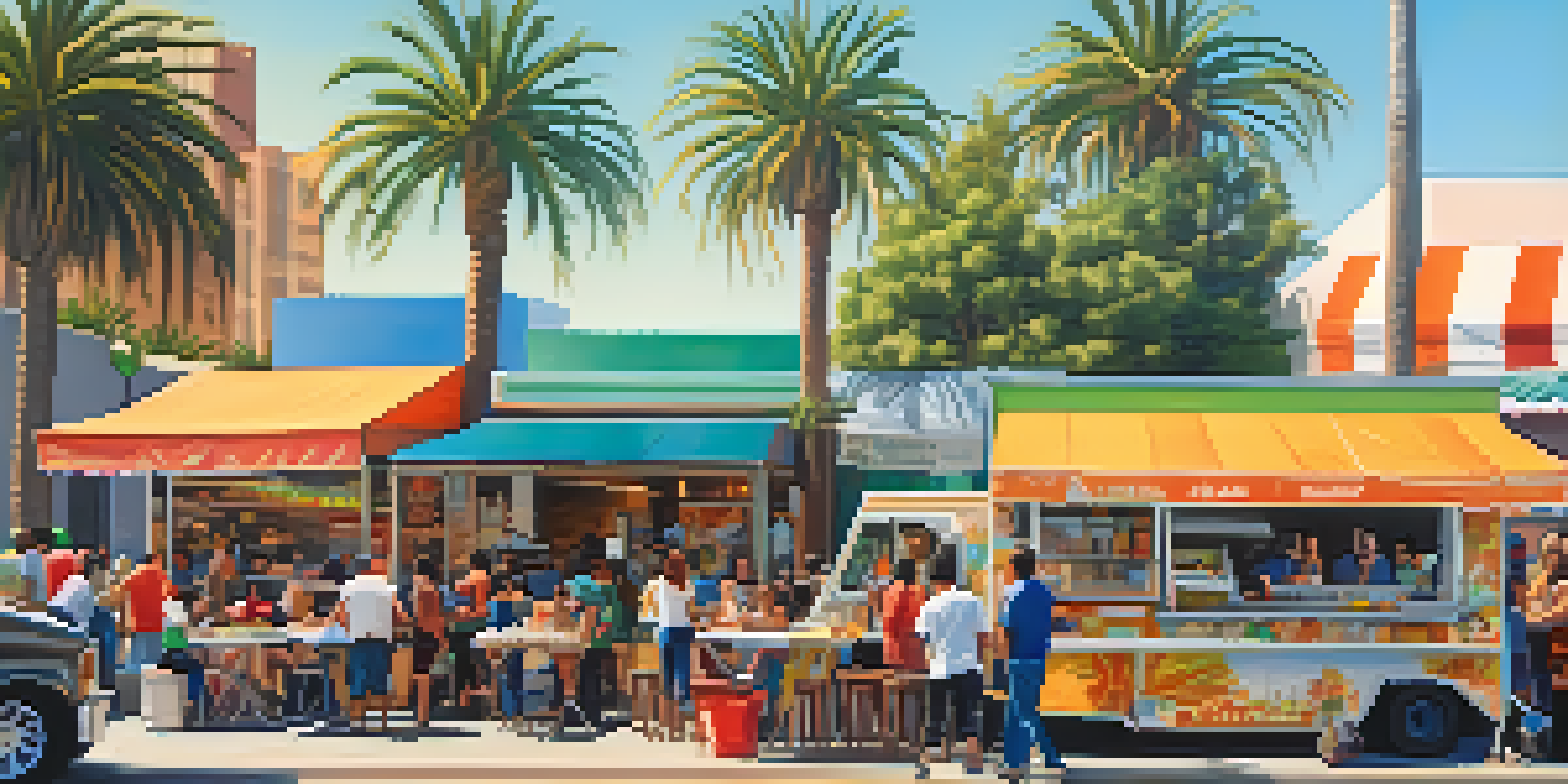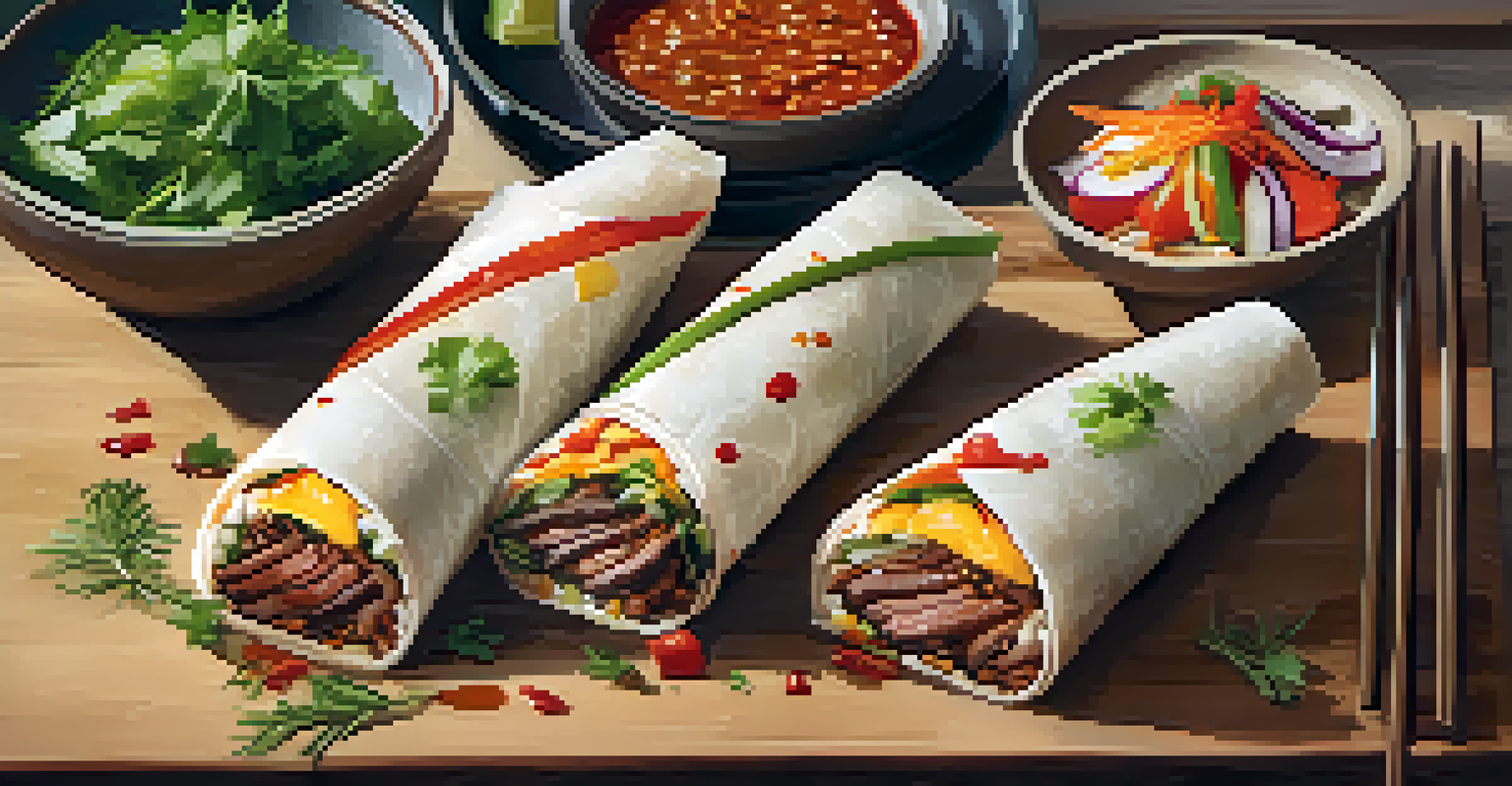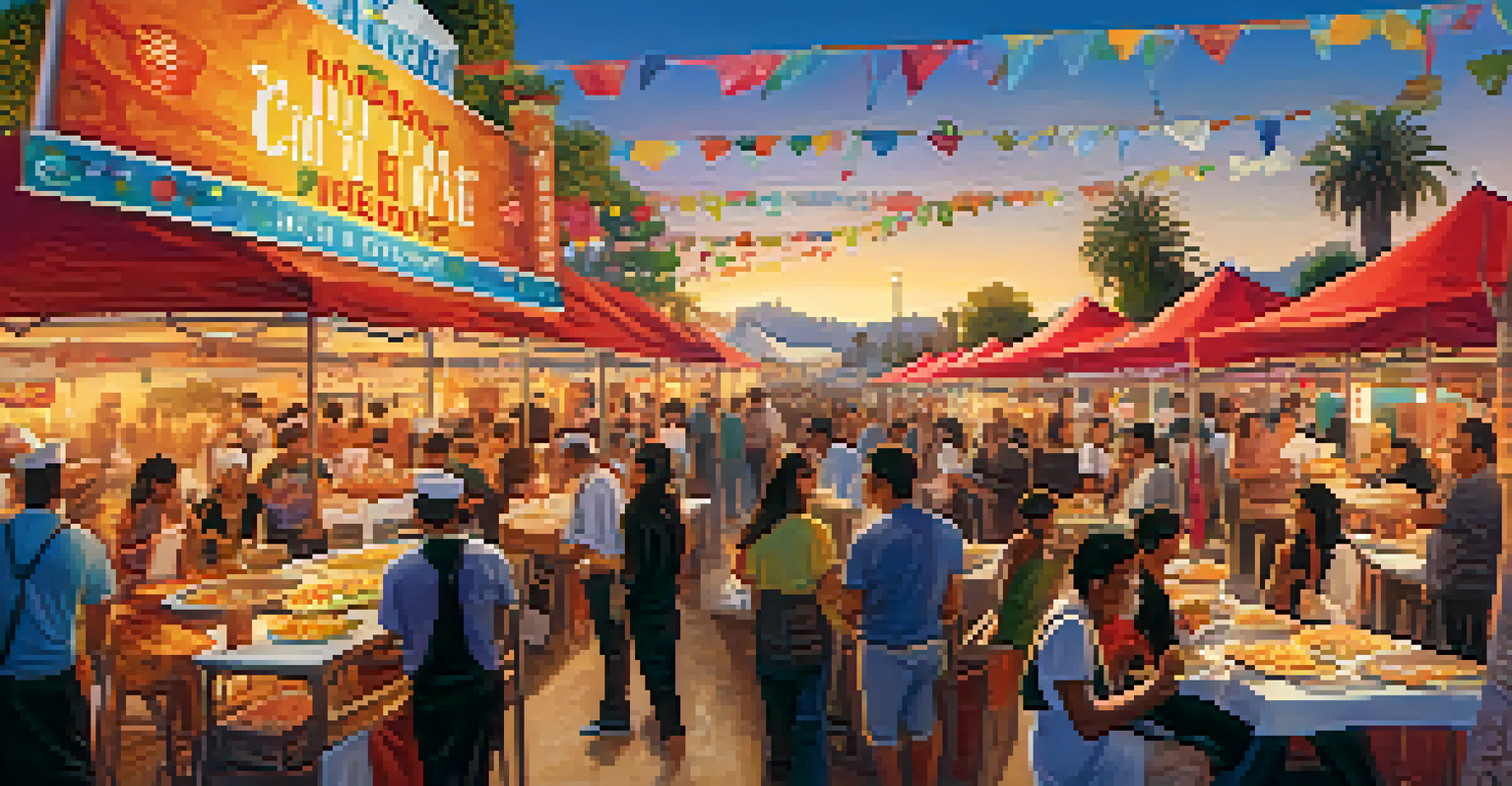Global Flavors: The Impact of Immigration on LA Cuisine

Los Angeles: A Melting Pot of Culinary Cultures
Los Angeles is often described as a melting pot, with its culinary scene reflecting the diverse cultures that have settled there. From Mexican tacos to Korean BBQ, the city offers an array of flavors that celebrate its immigrant roots. This vibrant food landscape showcases how different traditions blend and create something uniquely Los Angeles.
Food is the ingredient that binds us together.
Every neighborhood in LA tells a story through its food, revealing the influence of various immigrant communities. For instance, the bustling streets of Koreatown are filled with eateries serving dishes that highlight Korean flavors, while East LA is known for its rich Mexican cuisine. This diversity not only enhances the city’s culinary appeal but also fosters cultural exchange and understanding.
The fusion of flavors in LA cuisine exemplifies how immigration enriches the local food scene. Dishes like the Korean taco, a perfect marriage of Korean and Mexican cuisines, have emerged from this cultural confluence, showcasing the creativity and adaptability of chefs in the city.
Historical Roots of Immigration in Los Angeles
Understanding the impact of immigration on LA cuisine requires a look back at the city’s history. Waves of immigrants have arrived in Los Angeles since the late 19th century, each bringing their culinary traditions with them. These traditions have evolved over time, contributing to a dynamic food culture that continues to thrive today.

For example, the arrival of Mexican immigrants in the early 20th century laid the groundwork for the city's love for tacos and enchiladas. Similarly, in the 1970s and 1980s, the influx of Asian immigrants introduced flavors from Vietnam, China, and Thailand, forever changing the dining landscape. These historical migrations are integral to understanding the rich tapestry of flavors in LA.
Diverse Flavors Reflect Immigrant Roots
Los Angeles' culinary scene showcases a rich tapestry of flavors influenced by various immigrant communities, from Mexican tacos to Korean BBQ.
By embracing and celebrating these immigrant influences, LA has positioned itself as a global culinary capital. The city's food scene serves as a testament to the resilience and creativity of immigrant communities, who have enriched the area’s culture and economy through their culinary contributions.
Street Food: A Taste of Global Culture
One of the most exciting aspects of LA's culinary scene is its vibrant street food culture. Food trucks and street vendors offer a plethora of international cuisines, making it easy for anyone to experience global flavors on the go. From pupusas to banh mi, these street foods are often reflective of the cultural heritage of the vendors themselves.
Culinary arts are not just about cooking; they are about storytelling.
Street food has a unique way of connecting people and communities, often acting as a bridge between cultures. For instance, the popularity of taco trucks, primarily operated by Mexican immigrants, has helped introduce many Angelenos to authentic Mexican flavors. This accessibility creates opportunities for cultural exchange and appreciation.
Moreover, street food is not just about eating; it’s an experience. Gathering around food trucks or stalls, people from all walks of life come together, sharing stories and enjoying the diverse culinary offerings that reflect the city’s rich immigrant history.
Fusion Cuisine: The Art of Blending Flavors
Fusion cuisine is a prominent feature of Los Angeles dining, where chefs blend different culinary traditions to create innovative dishes. This culinary art form exemplifies how immigration has influenced the local food scene, pushing boundaries and encouraging creativity. Chefs often draw from their heritage and the flavors they encounter in their daily lives, resulting in unique culinary expressions.
Take, for example, the popular Korean BBQ burrito, which combines the marinated meats and grilled vegetables of Korean cuisine with the convenience of a burrito. This dish represents a perfect example of how cultural influences can lead to delicious new creations. The beauty of fusion cuisine lies in its ability to tell a story about the chef’s journey and experiences.
Street Food Connects Cultures
LA's vibrant street food culture offers a taste of global cuisine while fostering cultural exchange and community connections.
LA’s food scene thrives on experimentation, with restaurants and food trucks continuously evolving their menus to incorporate diverse influences. This constant innovation not only keeps the culinary landscape fresh but also highlights the importance of cultural exchange in shaping modern cuisine.
The Role of Immigrant Chefs in LA's Culinary Scene
Immigrant chefs play a crucial role in shaping Los Angeles' culinary identity. They bring authentic flavors and techniques from their homelands, ensuring that traditional recipes are preserved while also adapting to local tastes. These chefs often strive to provide a genuine dining experience that reflects their cultural heritage.
Many successful restaurants in LA are owned and operated by immigrant chefs who have turned their passion for cooking into thriving businesses. Their stories often mirror the immigrant experience, filled with challenges and triumphs, and their food serves as a celebration of their heritage. This connection to culture and community is what makes LA’s food scene so special.
Furthermore, immigrant chefs often act as cultural ambassadors, educating diners about their culinary traditions and the significance behind each dish. By sharing their stories and flavors, they foster greater understanding and appreciation for the diverse cultures that contribute to the city's rich culinary landscape.
Culinary Festivals: Celebrating Global Flavors
Culinary festivals in Los Angeles serve as a vibrant celebration of the city's diverse culinary landscape. These events bring together chefs, food lovers, and cultural communities to showcase their unique flavors and dishes. Festivals such as the LA Food & Wine Festival and the Night Market highlight the myriad of cuisines that reflect the city’s immigrant heritage.
At these festivals, attendees have the opportunity to sample an array of dishes from various cultures, allowing them to embark on a global culinary journey without leaving the city. From traditional dishes to innovative fusion creations, the festivals highlight the creativity and talent of local chefs. This exposure fosters a deeper appreciation for the complexity of LA’s food culture.
Immigrant Chefs Shape Culinary Identity
Immigrant chefs in Los Angeles preserve their culinary traditions while adapting to local tastes, enriching the city's dining experience.
Additionally, culinary festivals promote community engagement and cultural exchange, as people from different backgrounds come together to share their love for food. They also provide a platform for immigrant chefs to showcase their culinary skills, ensuring that their stories and flavors are recognized and celebrated.
The Future of LA Cuisine: Embracing Diversity
As Los Angeles continues to evolve, so too does its culinary landscape, driven by the influx of new immigrant communities. The future of LA cuisine promises to be even more diverse and exciting, as chefs experiment with flavors and techniques from around the world. This ongoing evolution ensures that the city remains at the forefront of culinary innovation.
Moreover, the rise of food consciousness among consumers means that there is a growing demand for authentic and diverse culinary experiences. Diners are increasingly seeking out restaurants that reflect the rich tapestry of cultures that make up Los Angeles. This trend encourages chefs to innovate while remaining true to their roots, creating a culinary scene that is both dynamic and authentic.

Ultimately, the impact of immigration on LA cuisine is an ongoing story that will continue to unfold. As new cultures and flavors enter the city, they will undoubtedly leave their mark, enriching the culinary landscape and fostering a deeper appreciation for the global influences that shape our plates.